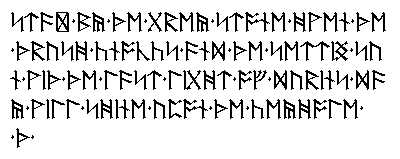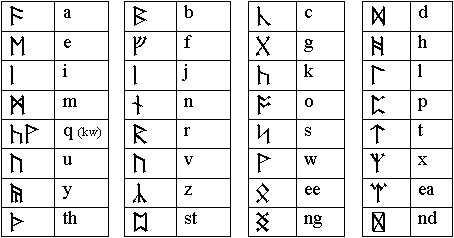Runes in "The Hobbit"
created by J.R.R. Tolkien
"The Hobbit" (by J.R.R. Tolkien) contains several examples of "Dwarf Runes", written on the map given to Thorin Oakenshield by his father. These runes can be translated into english by simple substitution. Below, I have recreated most of the runes used on the map and provided translations. The translations are in white so that you cannot see them unless you highlight them (click in the area to the left of the image and drag your mouse down over the text below). This is so that you can try to translate them yourself if you so desire. There is also an edition of the book "The Hobbit" that has a cover containing another statement in these runes. That is also shown and translated below. A table at the bottom of the page shows the translation of all known dwarven runes, including all those on the map and cover, and a few that Tolkien mentioned in the forward to the book.
You can download the font from this link.

"Five feet high the door and three may walk abreast.
Th. Th."
This is a description of the secret door that goes in the back side of the dwarves' mountain. The two "Th."'s are the initials of the creators of the map (Thror and Thrain). This text was written on the side of the map given to Thorin next to the image of a hand pointing at the side of the dwarves' mountain.

"Stand by the grey stone (hw)when the thrush knocks and the setting sun with the last light of Durin's Day will shine upon the keyhole.
Th."
This is a more exact definition of how to find the secret door, provided by Thrain. These runes were written in a special ink so that the would only show up under full moonlight in the middle of Thorin's map. Bilbo follows the directions and finds the door as described.

"The Hobbit, or, There and Back Again; being the record of a year's journey by Bilbo Baggins of Hobbiton. Complied by J.R.R. Tolkien and published by Houghton Mifflin and Co."
A somewhat humorous riddle created by Tolkien to challenge readers to translate runes on their own. All the other passages have translations provided in the text, but this one has to be deduced from the translations of the others. There are new runes in this text (the "ea" combination, for example), but Tolkien explains some of these in the forward.

Here's all the known runes as provided by the above texts and the forward in "The Hobbit". The double letters are not always used (for example, the "nd" rune never appears in the word "and", and the "st" rune was not used for "stand"), and the "x" and "z" runes are very rarely used. Occasionally, it appears, double vowels might be condensed into one rune (note the "oo" in "door" in the first example has been reduced to a single "o").
Back to the LotR index
Back to the main index



